

Sign In. Genome Research. Sign In. Genome Research. Frac-seq reveals isoform-specific recruitment to polyribosomes. The landscape of RNA polymerase II transcription initiation in C. elegans reveals promoter and enhancer architectures. Genome Research. Sign In. Genome Research. Frac-seq reveals isoform-specific recruitment to polyribosomes. Competition between virus-derived and endogenous small RNAs regulates gene expression in Caenorhabditis elegans. Genome Research. Sign In. The maize methylome influences mRNA splice sites and reveals widespread paramutation-like switches guided by small RNA. + Author Affiliations ↵* Corresponding author; email: martiens@cshl.edu The maize genome, with its large complement of transposons and repeats, is a paradigm for the study of epigenetic mechanisms such as paramutation and imprinting.

Here, we present the genome-wide map of cytosine methylation for two maize inbred lines, B73 and Mo17. CG (65%) and CHG (50%) methylation (where H = A, C or T) is highest in transposons, while CHH (5%) methylation is likely guided by 24nt, but not 21nt, small interfering RNA (siRNA). Correlations with methylation patterns suggest that CG methylation in exons (8%) may deter insertion of Mutator transposon insertion, while CHG methylation at splice acceptor sites may inhibit RNA splicing. Sign In. Abstract An expansive functionality and complexity has been ascribed to the majority of the human genome that was unanticipated at the outset of the draft sequence and assembly a decade ago.
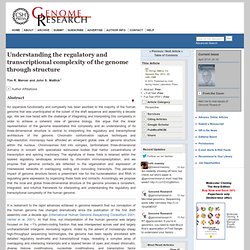
Quantitative proteomic analysis reveals concurrent RNA–protein interactions and identifies new RNA-binding proteins in Saccharomyces cerevisiae. + Author Affiliations Abstract A growing body of evidence supports the existence of an extensive network of RNA-binding proteins (RBPs) whose combinatorial binding affects the post-transcriptional fate of every mRNA in the cell—yet we still do not have a complete understanding of which proteins bind to mRNA, which of these bind concurrently, and when and where in the cell they bind.
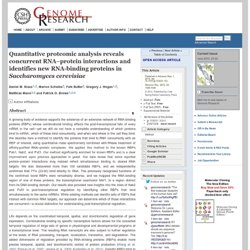
We describe here a method to identify the proteins that bind to RNA concurrently with an RBP of interest, using quantitative mass spectrometry combined with RNase treatment of affinity-purified RNA–protein complexes. We applied this method to the known RBPs Pab1, Nab2, and Puf3. Our method significantly enriched for known RBPs and is a clear improvement upon previous approaches in yeast.
A broadly applicable high-throughput screening strategy identifies new regulators of Dlg4 (Psd-95) alternative splicing. Pre-mRNA splicing patterns are highly regulated to produce functionally distinct gene products during development or in response to extracellular stimuli ( Black 2003 ; Chen and Manley 2009 ).
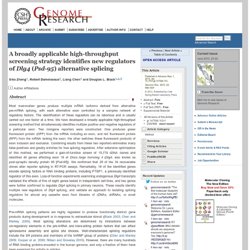
Most splicing alterations are determined by interactions between cis -regulatory elements in the pre-mRNA and trans -acting protein factors that can affect spliceosome assembly and splice site choices. Well-characterized splicing regulators include the SR proteins and members of the hnRNP group of proteins ( Chen and Manley 2009 ; Cooper et al. 2009 ; Nilsen and Graveley 2010 ). However, there are many hundreds of RNA binding proteins encoded in the human genome, and only a fraction of them have been examined for activity in splicing.
An alternative exon is usually controlled by multiple proteins, and the intronic sequences surrounding the exon can contain a variety of conserved regulatory elements. Results. Sign In. Structure-based whole-genome realignment reveals many novel noncoding RNAs. + Author Affiliations + Author Notes ↵ Present addresses: 5 Department of Computer Science, University of Leipzig, 04107 Leipzig, Germany; ↵ 6 Bioinformatics and Systems Biology Graduate Program, University of California San Diego, La Jolla, California 92093, USA.
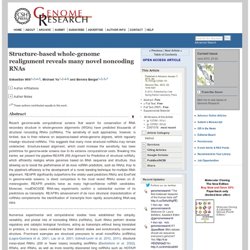
. ↵ 4 These authors contributed equally to this work. Abstract. Sign In. Genome of the pathogen Porphyromonas gingivalis recovered from a biofilm in a hospital sink using a high-throughput single-cell genomics platform. + Author Affiliations Abstract Although biofilms have been shown to be reservoirs of pathogens, our knowledge of the microbial diversity in biofilms within critical areas, such as health care facilities, is limited.
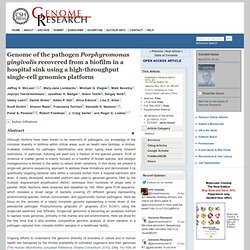
Available methods for pathogen identification and strain typing have some inherent restrictions. In particular, culturing will yield only a fraction of the species present, PCR of virulence or marker genes is mainly focused on a handful of known species, and shotgun metagenomics is limited in the ability to detect strain variations. In this study, we present a single-cell genome sequencing approach to address these limitations and demonstrate it by specifically targeting bacterial cells within a complex biofilm from a hospital bathroom sink drain. Here we have focused this approach on the indoor environment. The aim of this study was to investigate for the first time the bacteria present in a healthcare facility with a high-throughput single-cell genomics approach.
Results. Sign In. The 3′ untranslated regions (3′ UTRs) of mRNAs contain cis elements that confer post-transcriptional regulation by RNA-binding proteins (RBPs) and microRNAs (miRNAs) (Licatalosi and Darnell 2010).
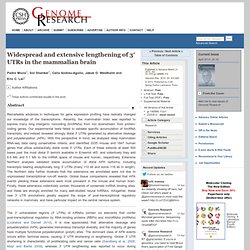
It is now appreciated that alternative cleavage and polyadenylation (APA) generates tremendous transcript diversity, and the majority of genes have multiple functional polyadenylation (polyA) sites. The dominant class of APA events occurs within terminal exons, causing 3′ UTR shortening or lengthening. Global 3′ UTR shortening is characteristic of proliferating cells and cancer cells (Sandberg et al. 2008; Mayr and Bartel 2009), whereas 3′ UTR lengthening was reported to occur during embryonic development and differentiation (Ji and Tian 2009). Microarray analysis of assorted tissues indicated that the mammalian brain broadly utilizes distal 3′ UTR species (Sandberg et al. 2008; Wang et al. 2008).
MMAPPR: Mutation Mapping Analysis Pipeline for Pooled RNA-seq. Several methods exist to expedite genetic mapping.
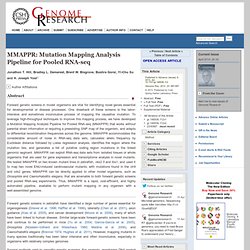
For example, genotyping DNA pooled from phenotype-sorted individuals (bulk segregant analysis) has long been a standard method for low-resolution genetic mapping. Bulk segregant analysis provides a qualitative estimate of the linkage between a given marker and the mutant locus, while greatly reducing the time and expense of genotyping. However, this method is still labor intensive because it requires that each marker be analyzed individually. An alternative to whole-genome sequencing (WGS) is RNA-seq, which is less expensive because the transcriptome is smaller than the genome, allowing greater read depth to be achieved with fewer reads.
Sign In. + Author Affiliations Abstract Forward genetic screens have elucidated molecular pathways required for innumerable aspects of life; however, identifying the causal mutations from such screens has long been the bottleneck in the process, particularly in vertebrates.
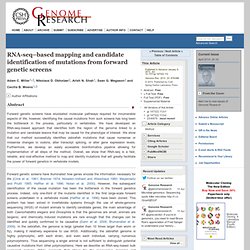
We have developed an RNA-seq–based approach that identifies both the region of the genome linked to a mutation and candidate lesions that may be causal for the phenotype of interest. We show that our method successfully identifies zebrafish mutations that cause nonsense or missense changes to codons, alter transcript splicing, or alter gene expression levels. Sign In. Most biological processes—such as embryonic development, differentiation, or cellular responses to external stimuli—are in essence dynamic, which requires the underlying transcriptional networks to be tightly temporally coordinated.

Several large-scale temporal studies have focused on the comprehensive mapping of dynamic changes of gene expression but have not revealed how coordination is achieved on the transcriptional level (e.g., van Wageningen et al. 2010). To address this question globally, the binding of regulatory proteins has been examined using methods such as chromatin immunoprecipitation with microarrays (ChIP-chip) or sequencing (ChIP-seq) (e.g., Sandmann et al. 2006a; Johnson et al. 2007; Vogel et al. 2007). Still, many such studies have operated with just one or two conditions. The exceptions include temporal examinations in the model systems Drosophila and yeast (Sandmann et al. 2006b; Jakobsen et al. 2007; Ni et al. 2009; Zinzen et al. 2009). Results Figure 1. Sign In. + Author Affiliations Abstract. Sign In. + Author Affiliations Abstract High-throughput RNA sequencing (RNA-seq) promises to revolutionize our understanding of genes and their role in human disease by characterizing the RNA content of tissues and cells.
The realization of this promise, however, is conditional on the development of effective computational methods for the identification and quantification of transcripts from incomplete and noisy data. In this article, we introduce iReckon, a method for simultaneous determination of the isoforms and estimation of their abundances. Our probabilistic approach incorporates multiple biological and technical phenomena, including novel isoforms, intron retention, unspliced pre-mRNA, PCR amplification biases, and multimapped reads. iReckon utilizes regularized expectation-maximization to accurately estimate the abundances of known and novel isoforms.
Sign In. The goal of this study was to generate a high-quality compendium of DNA methylation data across a large number of human cell lines and tissues. Reduced representation bisulfite sequencing (RRBS) was chosen because it provides quantitative, single-base resolution methylation profiles for a large subset of the human genome that is enriched for genic regions and CpG islands (CGIs) (Meissner et al. 2008). Other genomic assays have been performed in these samples as part of The ENCODE Project (The ENCODE Project Consortium 2007, 2011, 2012), providing a rich resource for integrated analysis of DNA methylation, gene expression, transcription factor binding, and chromatin modifications. We demonstrate that comparisons of methylation profiles across the diverse collection of samples in this study can be used to investigate cancer-associated methylation defects, cell-type specific methylation, and epigenetic changes induced by cell culture.
Results Quantifying DNA methylation Global observations. Sign In. Colonial division of labor into reproductive (e.g., queen) and functionally sterile (worker) castes is a hallmark strategy for social organization employed by all eusocial insects (Wilson 1953; Wheeler 1986; Hölldobler and Wilson 1990). A subset of ant species (Hymenoptera: Formicidae) have evolved further subdivision of workers into specialized castes, whereby signals initiated during larval development activate alternative ontogenies that generate complex variation in morphology, behavior, and lifespan among adults (Hölldobler and Wilson 1990).
Importantly, these caste-determining signals often derive from environmental—physical, nutritional (e.g., royal jelly), social—cues rather than genetic factors (Wheeler 1986, 1991; Schwander et al. 2010; Kamakura 2011; Rajakumar et al. 2012). Results. Sign In. Genes on the single X chromosome in Drosophila melanogaster males are subjected to transcriptional enhancement in order to meet the levels of expression product in females that carry two X chromosomes. This process is referred to as dosage compensation (DC). Even though similar compensatory processes can be observed in several unrelated heterogametic organisms, major principles and mechanisms differ substantially (Straub and Becker 2007; Mank 2009). Sign In. An epigenome consists of chemical modifications and protein variations to the DNA and histones, and some of these modifications and variations can be passed down to an organism's offspring (Bernstein et al. 2007).
SeqFold: Genome-scale reconstruction of RNA secondary structure integrating high-throughput sequencing data. Sign In. + Author Affiliations Abstract Hutchinson-Gilford progeria syndrome (HGPS) is a premature aging disease that is frequently caused by a de novo point mutation at position 1824 in LMNA. This mutation activates a cryptic splice donor site in exon 11, and leads to an in-frame deletion within the prelamin A mRNA and the production of a dominant-negative lamin A protein, known as progerin.
Sign In. + Author Affiliations ↵7 These authors contributed equally to this work. Differentially expressed, variant U1 snRNAs regulate gene expression in human cells. + Author Affiliations Abstract. RNA-seq based mapping and candidate identification of mutations from forward genetic screens. Forward genetic screens have elucidated molecular pathways required for innumerable aspects of life, however identifying the causal mutations from such screens has long been the bottleneck in the process, particularly in vertebrates.
We have developed an RNA-seq based approach that identifies both the region of the genome linked to a mutation and candidate lesions that may be causal for the phenotype of interest. We show that our method successfully identifies zebrafish mutations that cause nonsense or missense changes to codons, alter transcript splicing, or alter gene expression levels. SeqFold: Genome-scale reconstruction of RNA secondary structure integrating high-throughput sequencing data. 2013 CSHL Meeting on RNA & Oligonucleotides. Meetings & Courses Home. Sign In. Sign In. The GENCODE v7 catalog of human long noncoding RNAs: Analysis of their gene structure, evolution, and expression. The cellular economy is transacted by both proteins and nonprotein-coding RNAs.
Historically, proteins (and the messenger RNAs that encode them) have tended to dominate our view of the cell and its genome due to their abundance and to the relative ease with which protein-coding genes, and their gene products, can be identified and studied. However, in recent years this paradigm has been undermined as new technologies have provided accelerating depths of RNA sequencing. Sign In. + Author Affiliations + Author Notes. Computational analysis and characterization of UCE-like elements (ULEs) in plant genomes.
An increasing number of studies indicate that although the larger part of eukaryotic genomes consists of non-protein-coding DNA, this is far from being nonfunctional. Noise–mean relationship in mutated promoters. Analysis of gene expression from the Wolbachia genome of a filarial nematode supports both metabolic and defensive roles within the symbiosis. Human Mitochondrial DNA Replication. Sign In. Sign In. RIP-chip-SRM—a new combinatorial large-scale approach identifies a set of translationally regulated bantam/miR-58 targets in C. elegans. Observation of dually decoded regions of the human genome using ribosome profiling data. Sign In. Sign In. Sign In. Sign In. Chimeras taking shape: Potential functions of proteins encoded by chimeric RNA transcripts. Sign In. Structure-based whole genome realignment reveals many novel non-coding RNAs.
A miRNA-regulatory network explains how dysregulated miRNAs perturb oncogenic processes across diverse cancers. Sign In. Sign In. iReckon: Simultaneous isoform discovery and abundance estimation from RNA-seq data. The transcriptional landscape and mutational profile of lung adenocarcinoma. Cytoplasmic RNA-Binding Proteins and the Control of Complex Brain Function. Sign In. Sign In. Sign In. Genome-wide analysis of long noncoding RNA stability. Incorporating RNA-seq data into the zebrafish Ensembl genebuild.
Sign In. Detecting differential usage of exons from RNA-seq data. Integrative analysis of genome-wide loss of heterozygosity and monoallelic expression at nucleotide resolution reveals disrupted pathways in triple-negative breast cancer. Sign In. Extensive alternative polyadenylation during zebrafish development. Sign In. Sign In. Sign In. Sign In. GENCODE: The reference human genome annotation for The ENCODE Project. Combining RT-PCR-seq and RNA-seq to catalog all genic elements encoded in the human genome. RNA editing in the human ENCODE RNA-seq data. Long noncoding RNAs are rarely translated in two human cell lines. Deep sequencing of subcellular RNA fractions shows splicing to be predominantly co-transcriptional in the human genome but inefficient for lncRNAs.
Sign In. Sign In. Sign In. Adenosine deaminases that act on RNA induce reproducible changes in abundance and sequence of embryonic miRNAs. Sign In. Sign In.